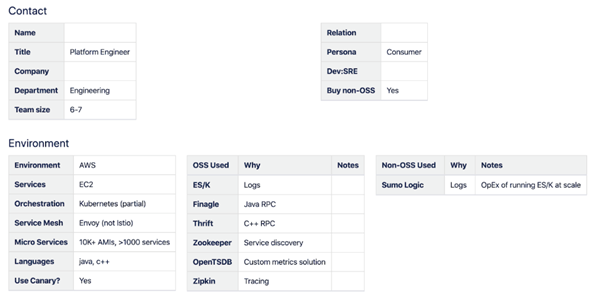
This guide is intended to detail the customer validation outreach process we recommend for Unusual Ventures portfolio companies at the Seed Stage. At the end of the process, your team should be able to deliver:
‣ A crisp articulation of the pain your company solves.
‣ A proven, repeatable outreach methodology to generate meetings with “target” customer types.
‣ At least 10 engaged customer prospects for proof of concept (POC) engagements.
All founders eventually reach a point where they tap out their personal network and have to conduct cold outreach to continue validating their idea. Part of ensuring your outreach is successful and gets the response you want is having the right outreach message. If your company is in stealth, make use of that because the intrigue encourages people to take the meeting. The outreach message should come from a founder/C-level executive to make the recipient feel special. Frame the text in the body of the message in a way that asks for feedback with a very crisp statement of the pain/value proposition.
Hi NAME,
Based on your IT compliance leadership at XXXX, I wanted to reach out about a new stealth company. I’m [NAME], CEO of [COMPANY], and we’ve built the first compliance solution designed to solve a critical problem that plagues IT teams — constant monitoring of WHO has access to WHAT, even in dynamic DevOps environments where creating and maintaining appropriate access policies is a tremendous challenge. We’re looking for leaders interested in seeing a demo of the solution and giving us feedback.
Backed by Unusual Ventures, the Shujinko solution platform is specifically built for a world where public cloud applications are being built at lightning speed and are often no longer behind corporate firewalls. Shujinko has the unique ability to provide visibility into what is accessible and by who AT ALL TIMES — that enables IT to move at the same speed as DevOps. The business can create as many public-facing cloud applications as it wants; compliance teams can finally keep up.
We’re hoping to get great feedback from security professionals such as yourself and help prepare the platform for a public launch. Would you be willing to take 30 minutes and take a look at what we’ve built?
Best regards,
Matt Wells
CEO
Hi NAME,
Thanks for connecting. I’ve spoken to a few engineers at your company but they weren’t close to observability and monitoring, so I’m excited to get connected with you.
I am the founder of a next-generation observability tool called Omnition. We are actually still in stealth [launching publicly next quarter] but I wanted to share our UI with some people who are working on distributed tracing. We are taking a new approach and I think it is really valuable to the space.
Are you open to seeing a demo next week?
Best,
Spiros
CEO
We’ve been working on a startup to bring an innovative approach to continuous delivery and DevOps. Our aim is to simplify and fully automate the deployment of complex applications. We are looking for a few engineering and devops leaders in the enterprise for validation and feedback on our approach. We are in stealth today but looking for as much feedback as possible before releasing our GA product. Please let me know if you’d be open to providing us feedback over a quick demo.
Best Regards,
Jyoti Bansal
CEO
Use the Navigator tool and search for individuals with keywords in their descriptions. (i.e., VP platform, director of data or compliance, director of IAM, Mulesoft user, Apigee, APIs)
Use tools such as Prospect, GetEmail.io, Datanise, Apollo, Connectifier, etc. to find the emails for the people you’ve identified. It’s ok to even guess an email address for high quality targets. This doesn’t scale, but that’s not important at the earliest stage.
Use a tool like Outreach to create multiple emails, so that a sequence can be sent over a period of time. Remember that it can take MANY emails before you ever get a response. (It can take 50 emails to get one meeting.)
Assuming your outreach is successful, you should have a meeting set up. Congrats! Now, your goal is to conduct a lightweight discovery and qualification process to determine if the prospect is a right fit for your product.
Slide 1
Slide 2
Slide 3
– Tell them your view of the pain and then ask, “Does this resonate with you?” You want to hear, “Yes, we see this all the time at our company…” if they do have that pain.
If you get positive answers to a) “Does this resonate with you?” and b) “Do you think our approach will work in an environment like yours?,” immediately ask:
“How would you make the business case to your boss to pay for this?”
This is one of the most important questions. You want to start hearing them articulate your business case and the value you offer. NOTE: In your first 10–15 calls, until a) and b) are clearly understood, you may never get to this question. When you do, listen to your customer’s articulation of the value proposition:
Ask: “Now that you have heard from us, how would you describe what we’re doing?
Follow-up: “Is our messaging right or do you think we should change how we describe ourselves?”
Your team must agree to a process for collecting, sharing, and analyzing customer feedback and conversations. One easy tactic to stay on the same page is designating a leader who takes detailed notes in each engagement and makes them available to the whole team. We recommend a shared Google doc or tracking in Confluence/Salesforce that captures:

The goal is to get 40–50 meetings and grouping them by customer type, defined by the “pain” you think they have.